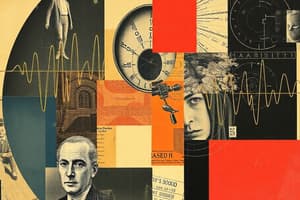Podcast
Questions and Answers
What frequency range can young people typically hear sounds?
What frequency range can young people typically hear sounds?
- 15 Hz to 25,000 Hz
- 5 Hz to 10,000 Hz
- 1 Hz to 15,000 Hz
- 20 Hz to 20,000 Hz (correct)
Which of the following professions is likely to involve exposure to noisy environments?
Which of the following professions is likely to involve exposure to noisy environments?
- Library assistant
- Office clerk
- Construction worker (correct)
- Electrician
What is the main reason for workers to wear ear protection?
What is the main reason for workers to wear ear protection?
- To prevent discomfort from sounds
- To avoid the hazards of loud sounds damaging their hearing (correct)
- To detect ultrasound frequencies better
- To enhance their hearing
Why can listening to music with headphones be harmful?
Why can listening to music with headphones be harmful?
What process do our ears use to convey sound to the brain?
What process do our ears use to convey sound to the brain?
What is the role of the ear in hearing?
What is the role of the ear in hearing?
Which part of the ear directly vibrates in response to sound waves?
Which part of the ear directly vibrates in response to sound waves?
What is the purpose of the cochlea in the hearing process?
What is the purpose of the cochlea in the hearing process?
What frequency range is typically difficult for people over 50 to hear?
What frequency range is typically difficult for people over 50 to hear?
What term is used for sounds that exceed the upper limit of human hearing?
What term is used for sounds that exceed the upper limit of human hearing?
Which of the following is a characteristic of hearing acuity in young people?
Which of the following is a characteristic of hearing acuity in young people?
What is the purpose of using a signal generator in hearing tests?
What is the purpose of using a signal generator in hearing tests?
What happens when a sound wave strikes a large obstacle?
What happens when a sound wave strikes a large obstacle?
Flashcards
What are ultrasound waves?
What are ultrasound waves?
Ultrasound waves are high-frequency sound waves that are used in various applications, including medical imaging, fishing, and exploring the ocean depths.
How do bats use ultrasound?
How do bats use ultrasound?
Bats use echolocation to navigate and hunt. They emit high-frequency sound waves (ultrasound) and listen to the echoes that bounce back from objects in their environment. The time it takes for the echoes to return tells them how far away objects are.
What is a typical hearing range for a young person?
What is a typical hearing range for a young person?
A young person's hearing range is typically between 20 Hz and 20,000 Hz. This means that they can hear sounds with frequencies within that range.
How do loud sounds affect your hearing?
How do loud sounds affect your hearing?
Signup and view all the flashcards
What is noise?
What is noise?
Signup and view all the flashcards
How we hear?
How we hear?
Signup and view all the flashcards
Ear canal
Ear canal
Signup and view all the flashcards
Eardrum
Eardrum
Signup and view all the flashcards
Three small bones
Three small bones
Signup and view all the flashcards
Cochlea
Cochlea
Signup and view all the flashcards
Nerve cells
Nerve cells
Signup and view all the flashcards
Hearing acuity
Hearing acuity
Signup and view all the flashcards
Ultrasound
Ultrasound
Signup and view all the flashcards
Study Notes
Hearing
- Sound waves are vibrations that travel through air and other materials.
- The ear detects sound waves.
- The ear canal transmits vibrations to the eardrum.
- The eardrum vibrates, causing three small bones to vibrate.
- Vibrations are transmitted to the cochlea (a fluid-filled tube).
- Vibrations in the cochlea excite nerve cells.
- Nerve cells send electrical signals to the brain for sound perception.
Hearing Acuity
- Young people have better hearing than older people.
- Young people can hear very faint and high-pitched sounds.
- Hearing ability decreases with age, particularly for faint and high-pitched sounds.
- A signal generator and a loudspeaker can measure the highest frequency that can be heard.
Limits of Hearing
- Most young people can hear sounds between 20 Hz and 20,000 Hz.
- Hearing range decreases with age.
- A 50-year-old person may not hear sounds above 15,000 Hz.
- Sounds above 20,000 Hz are called ultrasound, and only certain animals can hear them (e.g., bats).
- Ultrasound is used in medicine and other disciplines.
Noise
- Unwanted sounds are called noise.
- Loud noises can damage the ears.
- Noise-producing jobs often require hearing protection.
- Headphones at high volume can also damage the hearing.
Studying That Suits You
Use AI to generate personalized quizzes and flashcards to suit your learning preferences.




